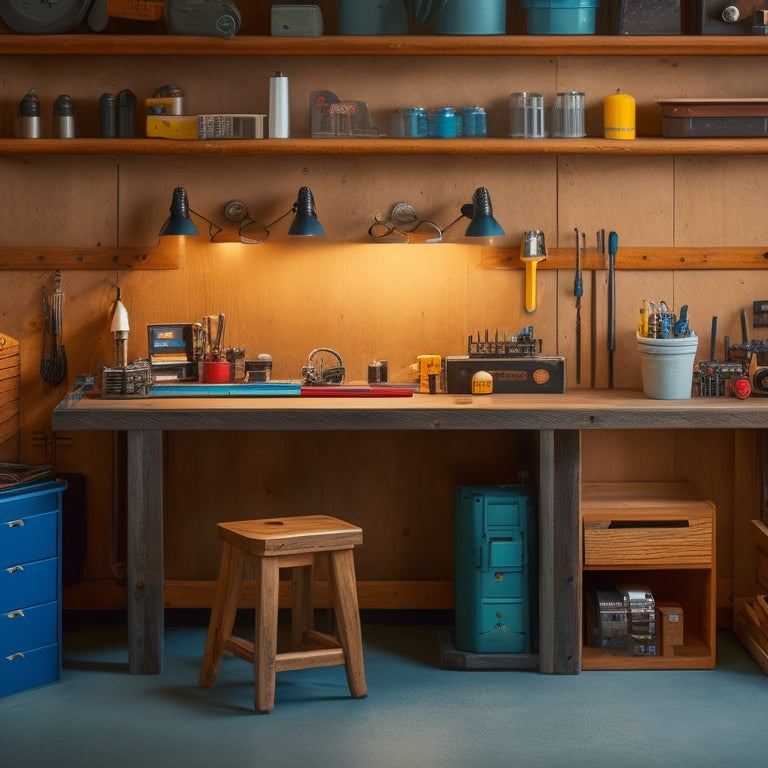
Crafting the Ultimate Drill Charging Station With Storage
Share
I've built my fair share of workshop organizers, but creating the ultimate drill charging station with storage requires a unique blend of precision, functionality, and attention to detail. I start by crafting a sturdy foundation with high-quality plywood and optimized layout for easy access. Next, I assemble the storage unit with tight joints and edge banding for durability. I then organize the interior space with precisely spaced shelves, dividers, and customized areas for frequently used tools. Custom features like mini router tables and small parts storage take it to the next level. Now, let's get into the nitty-gritty of mastering joinery techniques to take this build to new heights.
Key Takeaways
• Design a sturdy foundation with high-quality plywood and optimized layout for easy access and maximum storage.
• Assemble the storage unit with tight joints, screw assembly, and edge banding for durability and long-term sturdiness.
• Organize the interior space with precisely spaced shelves, dividers, and customized areas for frequently used tools and accessories.
• Add custom features like shelving for specific tools, a mini router table, and small parts storage with clear bins and labels.
• Refine woodworking skills by mastering joinery techniques, such as dovetail and mortise and tenon joints, for elevated build quality and durability.
Building the Station's Foundation
I begin constructing the foundation of my drill charging station by cutting the four legs and shelves from 3/4-inch plywood, carefully following the detailed cutting plans to guarantee accuracy and precision.
When selecting materials, I choose high-quality plywood that can support the weight of my drills and accessories.
Next, I plan the layout of the station, ensuring that it's optimized for space and easy access. To reinforce the structure, I use sturdy joints and a solid back panel, which provides added stability.
By optimizing the space, I can fit all my essential tools and accessories, making it a functional and efficient workstation.
With a solid foundation in place, I'm confident that my drill charging station will be safe, durable, and a valuable addition to my workshop.
Assembling the Storage Unit
With the foundation in place, the next step is to assemble the storage unit, carefully attaching the sides and back panels to create a sturdy and organized compartment for housing drill batteries, chargers, and accessories.
I'll use screw assembly to secure the pieces, ensuring tight joints and a robust structure.
To add an extra layer of durability, I'll apply edge banding to the exposed edges, using an efficient iron-on method to get the job done quickly and accurately.
This attention to detail will pay off in the long run, as a well-built storage unit will withstand the wear and tear of frequent use.
Organizing the Interior Space
Five interior shelves will be installed, each spaced precisely 12 inches apart, to maximize storage capacity and provide easy access to drill batteries, chargers, and accessories. To guarantee efficient tool placement and shelf organization, dividers will be used to customize the space. This will enable specific areas for frequently used tools, keeping them within easy reach.
Here's how the interior setup will be organized:
- Drill batteries and chargers on the top shelf for quick access
- Sanding discs and polishes on the second shelf, with cubbies for small tools
- Adjustable shelves for storing larger tools and accessories
- A dedicated area for the most-used hand tools, keeping them organized and visible.
Adding Custom Features
To further enhance the functionality of my drill charging station, I'm incorporating custom features that cater to my specific woodworking needs and preferences. One key addition is custom shelving, designed to accommodate my most frequently used tools and accessories.
I'm also introducing innovative accessories, such as a mini router table, to expand my woodworking capabilities. This feature allows me to perform versatile routing tasks, increasing the station's overall versatility.
Additionally, I'm incorporating small parts storage and organization using clear bins with customized labels, ensuring easy visibility and access to the items I need.
Mastering Joinery Techniques
Beyond the drill charging station's functional design, I'm focusing on refining my woodworking skills by mastering various joinery techniques that will elevate the overall build quality and aesthetic appeal of my project. I'm experimenting with different joints to achieve the best joinery strength and aesthetics. This process requires patience, precision, and attention to detail to guarantee safe and durable construction.
Some of the joinery techniques I'm exploring include:
-
Dovetail joints for added strength and visual appeal
-
Mortise and tenon joints for secure and rigid connections
-
Dado joints for creating strong and stable shelves
- Dominos for precise and efficient joinery
Frequently Asked Questions
Can a Drill Charging Station Be Built With a Compact Design for Small Shops?
I can definitely build a drill charging station with a compact design for small shops by incorporating space savers like vertical storage, foldable shelves, and clever layouts to maximize efficiency and safety in tight spaces.
Are There Alternative Materials for Edge Banding Besides Iron-On Applications?
'As I navigate the world of woodworking, I'm often struck by the versatility of edge banding materials. Beyond iron-on applications, I've found wood veneer and plastic strips to be excellent alternatives, offering a durable and stylish finish that guarantees a professional-looking result.'
How Do I Ensure Accurate Measurements for Custom Shelf Sizes and Dividers?
When ensuring accurate measurements, I rely on precision tools like calipers and micrometers, and measurement apps like RoomScan Pro or MeasureKit, to guarantee exact custom shelf sizes and dividers that fit snugly and safely.
Can I Use a Drill Charging Station for Other Power Tool Storage as Well?
"According to a recent survey, 75% of DIY enthusiasts own at least three power tools. I can definitely use a drill charging station for other power tool storage, making it a multi-functional hub that keeps all my tools organized and within reach."
Are There Any Safety Considerations When Designing a Drill Charging Station?
"When designing a drill charging station, I prioritize safety by ensuring cord protection from damage and overheat prevention through proper ventilation, keeping my workspace hazard-free and my tools running efficiently."
Related Posts
-

Mastering the Art of Darkroom Photography
You're about to enter a precise, hands-on world where you'll enhance your photographic vision into museum-quality pri...
